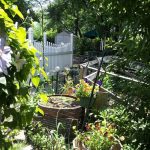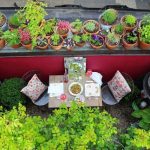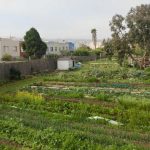Urban gardens


By Chelsea Frisbie From Mashable
Even in a city setting, it is possible to put your green thumb to good work.
By planting organisms that don’t require large areas to grow and using technology to sustainably encourage growth in available space, urban gardeners can provide food, greenery and commerce to their local communities — or just themselves.
According to the National Gardening Association, as of 2013, 35% of all U.S. households are growing food at home or in a community garden. There has been a 29% increase in food gardening by people living in urban areas since 2008.
The same survey found that millennials are the fastest growing group of gardeners; the number of people aged 18-34 who garden increased by 63% since 2008.
The following six organizations and bloggers have used their cityscapes to create flourishing gardens, combatting the misconception that urban gardens are necessarily “unclean.” They illustrate the core goal of the movement, to transform an underutilized resource into a benefit for the wider community.
1. Gotham Greens
IMAGE: GOTHAM GREENS
IMAGE: GOTHAM GREENS
Founded in Brooklyn in 2009, Gotham Greens now operates four facilities in New York and Chicago. With over 170,000 square feet of high-tech, these 100% clean energy-powered and climate-controlled urban rooftop greenhouses provide restaurants, retail and regular customers with year-round, sustainably farmed produce. Pictured is the flagship location in Greenpoint, Brooklyn.
2. Ron Finley Project
IMAGE: RON FINLEY
Ron Finley started with a simple idea: Use the vacant lots of Los Angeles and turn them into areas where food and plants can be grown. He wants to make healthy food accessible and gardening “gangsta.” Finley is currently raising money for his next big idea, an urban garden in South Central LA he’s calling “HQ,” proof urban gardening is possible, sustainable and beneficial to the community. People will be able to buy their own healthy meals, plant their own gardens and gather in a community setting.
3. Uncommon Ground
IMAGE: ALLISON GLOVAK, UNCOMMON GROUND
Located in Chicago, this former coffee shop has grown into a full restaurant and music venue and is the first certified organic brewery in Illinois. The 650-square-foot farm grows over 50 different crops and over 100 different varieties every season. Uncommon Ground focuses on products that are usually on the more expensive side, like organic herbs or heirloom tomatoes, and items that are “heavy producers with quick harvest times,” says Farm Director Allison Glovak. “By doing this, we can maximize the output of our tiny farm and really make a dent in our kitchen costs. Everything we grow is from seed, either directly sown on the roof or started under lights in our growroom in the basement.”
4. My City Garden
IMAGE: CAROL NISSEN
IMAGE: CAROL NISSEN
This blog chronicles a small garden’s progress in the Hilltop Area of Jersey City, New Jersey. Carol Nissen gets about three to four harvests per week of things like greens, herbs, peppers and small tomatoes. “Not a huge amount but enough to add to a healthy diet,” she wrote in an email. In a 6-by-4-foot raised bed, several large pots and five fence boxes, Nissen grows things like Pak Choi, snow peas, radishes and even a dwarf bartlett pear tree.
5. 66 Square Feet
IMAGE: MARIE VILJOEN, 66 SQUARE FEET
Marie Viljoen started with just 66 square feet of gardening space in Brooklyn, pictured above. She later moved to Harlem where the space for gardening tripled, but is currently back in Brooklyn in her “Chez Mosquito,” a.k.a. terrace garden. “I have gardened with no outdoor space: thyme on the windowsills, and basil in the bathroom (it had really good light); on a tiny terrace, where I could pick blueberries growing in a container, or roses to cut and bring inside; and now in-ground, where I have enough arugula to last a lifetime,” says Viljoen.
6. Little City
IMAGE: LITTLE CITY
This 3/4-acre farm in San Francisco, California, acts as a “small farm, educational site” and an example of the founder’s mission: Urban farming is something Americans can do, as other countries make it possible. The farm provides a variety of greens, herbs and seasonal produce to the community. Besides, the farm is bursting with beautiful flowers.
TOP IMAGE: GETTY IMAGES GOTHAM GREENS, ALLISON GLOVAK, UNCOMMON GROUND, MARIE VILJOEN, 66 SQUARE FEET
For more on this story go to: http://mashable.com/2016/04/27/urban-gardens/?utm_source=feedburner&utm_medium=feed&utm_campaign=Feed%3A+Mashable+%28Mashable%29&utm_content=Google+Feedfetcher#Ibjhhb4akuqW













